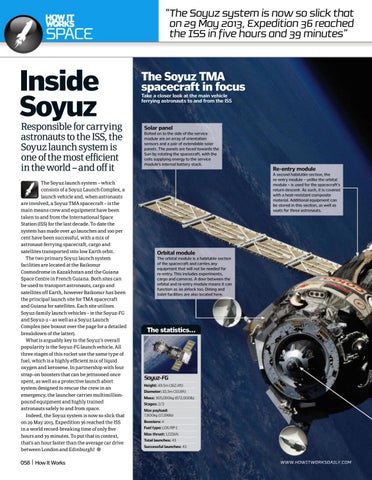“The Soyuz system is now so slick that on 29 May 2013, Expedition 36 reached the ISS in five hours and 39 minutes”
SPACE
Inside Soyuz
Responsible for carrying astronauts to the ISS, the Soyuz launch system is one of the most efficient in the world – and off it
The Soyuz launch system – which consists of a Soyuz Launch Complex, a launch vehicle and, when astronauts are involved, a Soyuz TMA spacecraft – is the main means crew and equipment have been taken to and from the International Space Station (ISS) for the last decade. To date the system has made over 40 launches and 100 per cent have been successful, with a mix of astronaut-ferrying spacecraft, cargo and satellites transported into low Earth orbit. The two primary Soyuz launch system facilities are located at the Baikonur Cosmodrome in Kazakhstan and the Guiana Space Centre in French Guiana. Both sites can be used to transport astronauts, cargo and satellites off Earth, however Baikonur has been the principal launch site for TMA spacecraft and Guiana for satellites. Each site utilises Soyuz-family launch vehicles – ie the Soyuz-FG and Soyuz-2 – as well as a Soyuz Launch Complex (see boxout over the page for a detailed breakdown of the latter). What is arguably key to the Soyuz’s overall popularity is the Soyuz-FG launch vehicle. All three stages of this rocket use the same type of fuel, which is a highly efficient mix of liquid oxygen and kerosene. In partnership with four strap-on boosters that can be jettisoned once spent, as well as a protective launch abort system designed to rescue the crew in an emergency, the launcher carries multimillionpound equipment and highly trained astronauts safely to and from space. Indeed, the Soyuz system is now so slick that on 29 May 2013, Expedition 36 reached the ISS in a world record-breaking time of only five hours and 39 minutes. To put that in context, that’s an hour faster than the average car drive between London and Edinburgh!
058 | How It Works
The Soyuz TMA spacecraft in focus Take a closer look at the main vehicle ferrying astronauts to and from the ISS
Solar panel Bolted on to the side of the service module are an array of orientation sensors and a pair of extendable solar panels. The panels are faced towards the Sun by rotating the spacecraft, with the cells supplying energy to the service module’s internal battery stack.
Re-entry module A second habitable section, the re-entry module – unlike the orbital module – is used for the spacecraft’s return descent. As such, it is covered with a heat-resistant composite material. Additional equipment can be stored in this section, as well as seats for three astronauts.
Orbital module The orbital module is a habitable section of the spacecraft and carries any equipment that will not be needed for re-entry. This includes experiments, cargo and cameras. A door between the orbital and re-entry module means it can function as an airlock too. Dining and toilet facilities are also located here.
The statistics…
Soyuz-FG Height: 49.5m (162.4ft) Diameter: 10.3m (33.8ft) Mass: 305,000kg (672,000lb) Stages: 2/3 Max payload: 7,800kg (17,196lb) Boosters: 4 Fuel type: LOX/RP-1 Max thrust: 1,021kN Total launches: 43 Successful launches: 43
WWW.HOWITWORKSDAILY.COM








